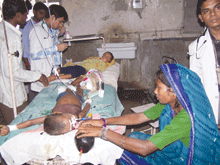 In the run-up to India’s 15th general election, with the manifestos of all political parties silent or given to making perfunctory noises about reform and repair of the country’s dysfunctional K-12 education system, education promotion NGOs frustrated by political indifference to education issues, have started encouraging educationally under-served children to speak up for themselves. On April 19, 90 children residing in five slums in Lucknow convened at the city’s K.D. Singh Babu stadium to present an alternative Children’s Manifesto 2009.
In the run-up to India’s 15th general election, with the manifestos of all political parties silent or given to making perfunctory noises about reform and repair of the country’s dysfunctional K-12 education system, education promotion NGOs frustrated by political indifference to education issues, have started encouraging educationally under-served children to speak up for themselves. On April 19, 90 children residing in five slums in Lucknow convened at the city’s K.D. Singh Babu stadium to present an alternative Children’s Manifesto 2009.
Drafted and printed by three local child-centric NGOs (Ehsas, Dharm Bharti Mission and Project Vijay), Children’s Manifesto 2009 focuses on five issues — the meagre allocation for child protection in the Union budget (only 0.03 percent of the Central budget and even less in UP); pitiable allocations for education and health (against the promised 6 percent and 3 percent of GDP per year for education and health, government (Centre plus states) expenditure has never exceeded 4 percent and 1 percent respectively); immunisation coverage of less than 25 percent of the state’s children (according to the state government’s own The State of Children in Uttar Pradesh Report, released in January 2008, only 22.9 percent of the state’s children under age five have been immunised); pervasive malnutrition (49.3 percent of children under age three are under-nourished) and steady decline in female-male sex ratio (in 1991 it was 927:1000; now 916:1000).
Against the backdrop of political and middle class indifference to UP’s (poor) children, Augustine Veliath, commun-ications specialist at Unicef’s Uttar Pradesh office, says the time has come for children themselves to protest. “Nobody knows the problems and deprivations of children as children themselves. So they need to speak up. We are ready and willing to provide them platforms from which they can speak,” he says.
Thus on the occasion of the release of the Children’s Manifesto 2009, Parveen Bano (10), daughter of daily wagers on construction sites, said: “At functions like this we get bottled water. But what we want is water for everyday use. There is no water anywhere near where I live.”
Added Abha Kumari (13) who lives in the city’s Nishatganj slum habitation: “As long as children are made to work without proper schooling there is no future for this state, or the country.”
Shachi Singh, convener of Ehsas, one of the NGOs which helped draft the manifesto, says that widespread illiteracy and quasi-literacy among slum children cannot be a reason to refuse them a voice. “Often children on the margins have greater awareness of children’s priorities since they suffer extreme injustice and deprivation. Children tell you like it is without frills, without diplomacy.”
Ajeet Pal Singh of the Dharam Bharti Mission believes that a formal written Children’s Manifesto will serve as a good reference point. “This manifesto has been sent to candidates of all political parties. Based on its demands, we will continue asking questions and confronting political parties. In effect this document is a formal no confidence motion moved by children against politicians of all ideologies, telling them that they have failed them completely. The truth is that our schools, hospitals, policy-makers, teachers and each one of us, has failed them.”
Undoubtedly publication of the Children’s Manifesto 2009 is an important first step in that it places the major grievances of UP’s short-changed children on record. But it will take a much greater effort to give the manifesto a place of honour on the agendas of the state’s indifferent political parties.
Vidya Pandit (Lucknow)